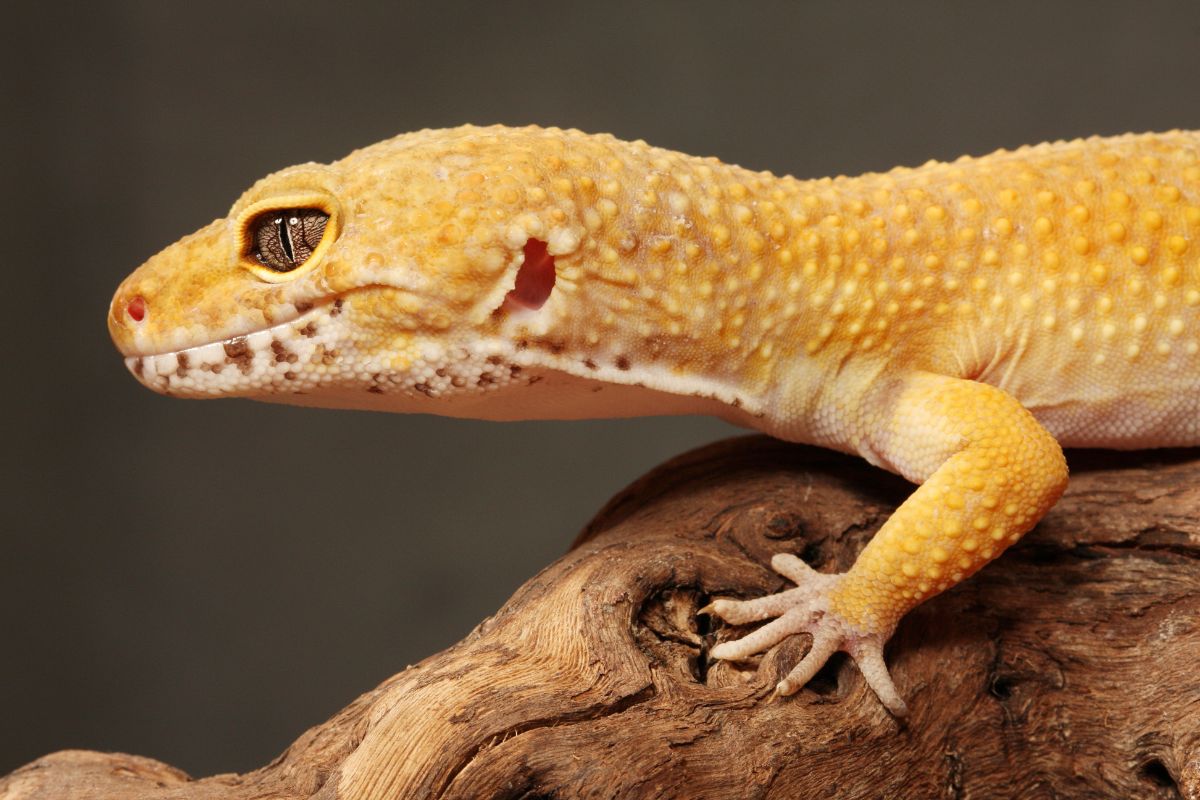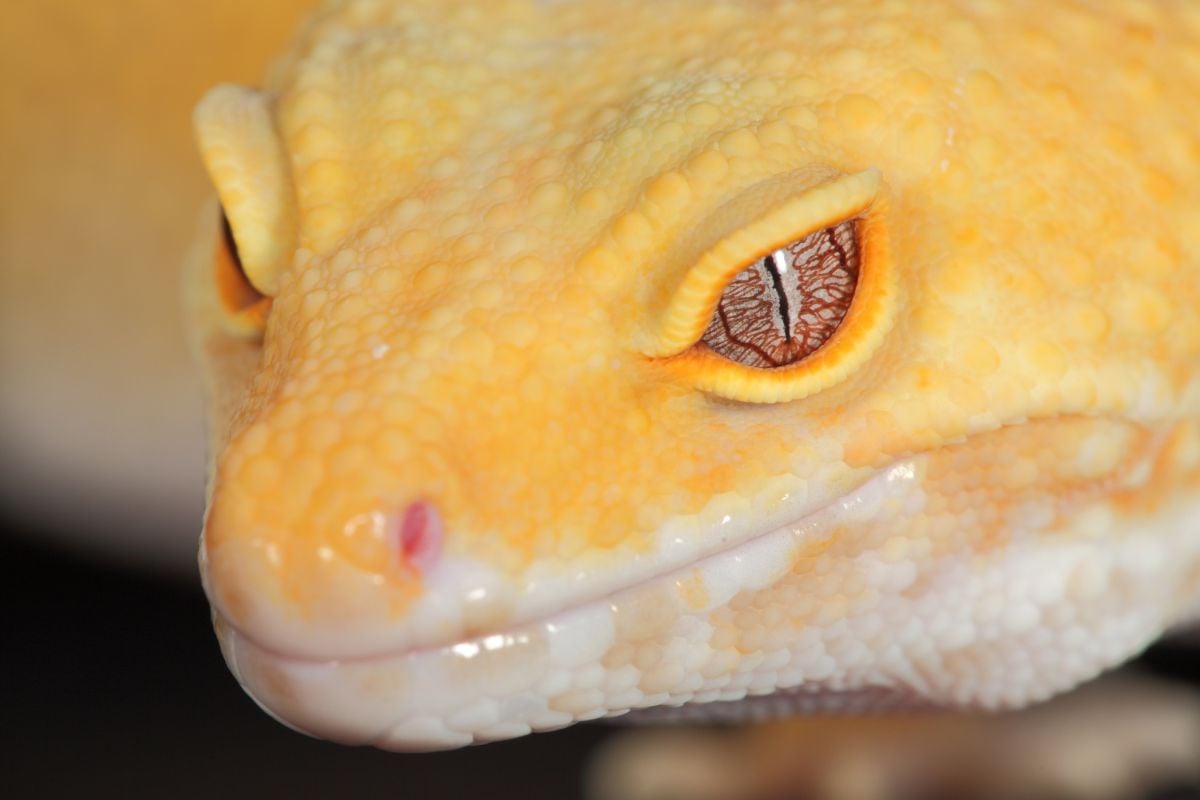Renowned for its distinctive leopard-like pattern, leopard geckos are a type of reptile that’s perfect for beginners. They are relatively easy to care for, requiring very little attention.
They make ideal pets thanks to their docile natures.

It’s important to take the correct steps when caring for your leopard gecko (see also “Leopard Gecko Gender Guide“). For instance, you should know how frequently they need to be fed.
This will ensure that the reptile gets the right amount of food, as overfeeding or underfeeding a leopard gecko can be harmful.
This guide will give you all the information you need to know about feeding leopard geckos (see also “Complete Leopard Gecko Poop Guide“)!
How Frequently Should You Feed A Leopard Gecko?
The frequency with which you should feed your leopard gecko will depend on its age. Younger leopard geckos are still developing and growing, meaning that they need to be fed more regularly than mature geckos.
During this stage, this species will need plenty of nutrients and macronutrients, primarily protein.
This simple table will help you to determine how often you should be feeding your reptile:
| Age | Feeding Frequency |
| 0-4 months | Every day |
| 4-6 months | Every 1-2 days |
| 8-12 months | Every 2 days |
| 12 months + | Every 2-3 days |
How Much Do You Need To Feed A Leopard Gecko?
Now that you know a little more about the frequency of feeding, you might be wondering about portioning. To stop your gecko from falling into an unhealthy weight bracket, pet owners need to give this reptile the correct amount of food.
If you have a baby leopard gecko, it’s advised that you feed them between 5 and 7 small insects every day. Ensure that these insects are small enough for your reptile to easily consume.
The majority of this diet should consist of crickets and mealworms.
Once your leopard gecko is a few months older, you can begin to increase its portions. Namely, they can eat between 6 and 7 large insects when they have reached adulthood.
It’s important to adjust this diet according to the individual leopard gecko. Some will need more food than others. To ensure that your pet is healthy, gecko owners need to make certain that their leopard gecko is of a healthy weight.
If a leopard gecko is underweight, this is an indication that you will need to provide more food. However, if the gecko is above the average weight for its age, this could suggest that you are feeding it too much.
A newly hatched leopard gecko should weigh between 2 and 4 grams or 0.07 and 0.14 ounces. A baby leopard gecko usually weighs between 15 and 30 grams/ 0.53 and 1.01 ounces.
Meanwhile, a juvenile reptile should weigh approximately 30 to 45 grams/ 1.01 to 1.58 ounces. Finally, an adult leopard gecko tends to be in the region of 45 and 90 grams/ 1.58 and 3.17 ounces.
These average weights should inform your portioning.
When Should You Feed A Leopard Gecko?
It’s recommended that you form a consistent feeding routine for your leopard gecko. Namely, you should try to feed it around the same time of day.
For instance, if it is more convenient for you to feed the gecko in the morning, attempt to stick to this routine.
Leopard geckos are crepuscular creatures. This means that they are more active during twilight periods. As a result, it is recommended that you feed the gecko during the dusk hours.
What Should You Feed To A Leopard Gecko?
The diet of a leopard gecko is primarily filled with insects. Live insects are preferable for your reptile. Mealworms and crickets are perhaps the best options for your leopard geckos.
However, they will also happily eat silkworms, cockroaches, butterworms, superworms, and waxworms.
It’s best to reserve some insects for special occasions, as certain insects will contain less nutritional value than others.
This is certainly the case when it comes to waxworms and superworms, which are rich in fat. If you feed too many of these worms to your gecko, it could put on too much.
This will lead to obesity, which will make your gecko vulnerable to a range of health issues. Likewise, butterworms should only be a rare treat.
Though insects will form the foundation of a leopard gecko’s diet, you can also enhance their consumption of nutrients by coating these insects in calcium powder. While leopard geckos need calcium, many insects are not high in this nutrient.
When constructing a diet for your leopard gecko, you should take into account the personal taste of your reptile. If it prefers a certain insect over others, you can primarily feed it that insect.
On the flip side, if there are certain insects that it avoids, it’s best to omit these insects from the diet.
Alongside this food, you should also ensure that your leopard gecko has a good supply of water. You will only need to provide a relatively shallow bowl of clean water.
Leopard geckos can go for a few days without water, so they are unlikely to drink it frequently.
As insectivores, leopard geckos will not eat fruits and vegetables. They will not attempt to eat any fruits or vegetables, as the body of this gecko is not suitable for digesting them.

How Should You Feed A Leopard Gecko In Brumation?
When the weather gets cold, humans aren’t the only ones that feel sluggish. Many reptiles, including geckos and snakes, will experience brumation.
Brumation describes a dormant and inactive period that reptiles go through during winter, in which their bodies become less active so that they can conserve energy.
A leopard gecko will not be entirely inactive during these periods, as it may still walk around its enclosure. Brumation is completely optional when you care for a leopard gecko as a pet.
If you decide that you want to initiate brumation, you must first take your leopard gecko to the vet. This is because the vet will be able to perform a parasite test, which will determine whether or not it’s suitable for brumation.
Additionally, you will need to give your leopard gecko a fasting period of approximately 2 wells before it goes into brumation. The reason for this is that the leopard gecko needs to clear its digestive tract before entering this dormant state.
If food is still within the digestive tract, it will rot. In turn, this could poison the gecko.
Whilst the leopard gecko is in brumation, you don’t have to feed it. However, once brumation has concluded, you will need to compensate by giving your geck more food than you usually would.
During this time, the reptile will have lost a significant amount of fat, which it may need to put back on to maintain a healthy weight.
How Should You Feed A Leopard Gecko That’s Laying Eggs?
The word “gravid” refers to a reptile that is preparing to lay eggs. Because of this, a gravid leopard gecko will need more nutrients than normal.
Specifically, they will need calcium and protein, both of which are essential for laying eggs.
To ensure that your gravid leopard gecko gets all of the nutrients that she needs, you need to offer a diet that is high in protein and other important nutrients.
Your leopard gecko may not eat this food (see also “How Long Leopard Geckos Can Go Without Food“). Many gravid leopard geckos will stop eating, as their bellies become too bloated to consume food.
Consequently, attempting to eat food can lead to extreme discomfort for your precious reptile.
Nonetheless, you need to provide it so that she can nibble on this food if she is peckish. Ensure that you provide food for a gravid gecko daily.
Frequently Asked Questions
Can You Overfeed A Leopard Gecko?
Yes, it’s possible to overfeed your leopard gecko. However, this rarely happens. The reason for this is that most leopard geckos will not overeat. Regardless, it’s important not to give your gecko too much food, as this could result in obesity.
Why Do Leopard Geckos Need Lots Of Protein?
The majority of a leopard gecko’s diet comes from protein. As insectivores, these geckos mainly eat protein in the form of insects. This is because protein is the main nutrient that leopard geckos need, alongside calcium.
Crickets are a great source of protein for your beloved reptile.
Can A Leopard Gecko Live Without Crickets?
Crickets are one of the best options for feeding your gecko. However, keeping live crickets can be quite tiresome, especially because they make loud noises.
Luckily, there are plenty of other insects that you can feed to your leopard gecko. Primarily, mealworms are a superb substrate for crickets.
Final Thoughts
If you are looking for a low-maintenance pet that’s super fun to care for, a leopard gecko is an outstanding option. Of course, if you want to care for one of these reptiles, you must feed it properly.
To do this, you will need to know not only what foods you should give your leopard gecko, but also the frequency with which this reptile needs to be fed (see also “Do Leopard Geckos Have Teeth?“).
- Can Leopard Geckos Eat Silkworms? - March 11, 2024
- Do Leopard Geckos Climb? - March 4, 2024
- Do Leopard Geckos Bask? The Answer Will Surprise You - February 21, 2024
